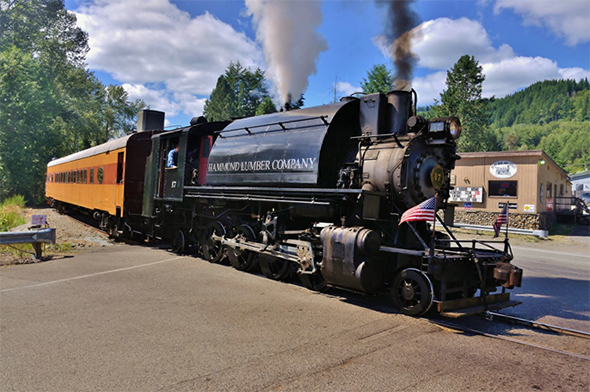
The FRA released a revised schedule of fees assessed in the case of any penalties found during FRA audits and inspections. This may impact all railroads, even small tourist carriers that operate vintage steam like the Mt. Rainier Scenic Railroad, seen here passing through a grade crossing in Elbe, Washington on the 4th of July weekend. Image © 7/2016 by Nikki Burgess; all rights reserved.
Last week’s DG Digest was pre-empted by an otherwise very busy schedule here at Labelmaster; so, this week, we’ll be covering the last two weeks instead of just one. Gosh it’s been busy! Whatever happened to the “lazy crazy hazy days of summer?” Gone with the song, apparently.
Herewith, the action on the DG/EH&S front over the last two (count em’!) weeks:
The FRA
- The Federal Railroad Administration is informing the public it has revised the Annual Positive Train Control (PTC) Progress Report Form (Form FRA F 6180.166. FRA revised the Annual PTC Progress Report Form based on comments it received from industry stakeholders on a related information collection. FRA is soliciting further public comment on specific aspects of the proposed form. Comments must be received no later than August 22, 2016. Here’s the request
- The FRA is adjusting the minimum penalty, ordinary maximum penalty, and the aggravated maximum penalty that it will apply when assessing a civil monetary penalty for a knowing violation of the Federal hazardous material transportation laws or a regulation, special permit, order, or approval issued under those laws. Here are the new levels
- In related action, the FRA is adjusting the minimum, maximum, and aggravated maximum penalties that it will apply when assessing a civil penalty for a violation of a railroad safety statute, regulation, or order under its authority. This interim final rule is effective August 1, 2016. See the new penalty structure here
FMCSA
The Federal Motor Carrier Safety Administration amended the civil penalties listed in its regulations to ensure that the civil penalties assessed or enforced by the Agency reflect the statutorily mandated ranges as adjusted for inflation. FMCSA is required to promulgate a catch-up adjustment through an interim final rule. This interim rule is effective on August 1, 2016. See the new rates here
PHMSA
- DOT’s PHMSA released an ICR related to its Hazardous Materials Incident report forms. This collection is applicable upon occurrence of an incident as prescribed in 49 CFR 171.15 and 171.16. A Hazardous Materials Incident Report, DOT Form F 5800.1, must be completed by a person in physical possession of a hazardous material at the time a hazardous material incident occurs in transportation, such as a release of materials, serious accident, evacuation, or closure of a main artery. Incidents meeting criteria in§ 171.15 also require a telephonic report. See the new ICR criteria here
- PHMSA is revising the maximum and minimum civil penalties for a knowing violation of the Federal hazardous material transportation law or a regulation, order, special permit, or approval issued under that law. As you may expect, the penalties are going up! Here is the rule
- In the (two!) weeks’ biggest news, PHMSA released a proposed amendment to the HMR under HM-219. The link appears below, and here is a summary of the major proposed actions:
- Revise approved testing methods for aerosols.
- Revise a table related to cargo tank specifications.
- Update the IBR citation for chlorine tank cars.
- Address inconsistencies between international and domestic labels.
- Revise the vessel requirement to notify the Captain of the Port (COTP) to the presence of limited quantities of hazardous materials.
- Revise testing requirements for packages to allow liquids to be used in place of solid materials.
- Add a shipping description for roadway striping vehicles.
- Extend the service life of tank cars authorized under HM–246 to the full service life of other tanks cars authorized under § 215.203 of the Federal Railroad Administration (FRA) regulations.
- Permit the use of pallets made of non-wood materials for limited quantities.
- Revise requirements for when emergency response numbers are required for excepted quantities.
- Change units for limited quantities of ethyl alcohol to the International System of Units.
- Propose changes concerning valve requirements for cylinders as outlined in ‘‘CGA V–9–2012, Compressed Gas Association Standard for Compressed Gas Cylinder Valves, Seventh Edition.’’
- Incorporate CGA standard ‘‘CGA C–7–2014, Guide to Classification and Labeling of Compressed Gases, Tenth Edition.’’
- Remove requirement for the marking of the service pressure on DOT 8 and DOT 8L cylinders.
- Revise recordkeeping requirements for certain cargo tanks certified in accordance with the ASME Code.
- Revise the printing tolerances for label and placard sizes.
- Incorporate Department of Defense (DoD) explosives manual into § 171.7.
- Allow use of electronic manifest.
- Amend the HMR to acknowledge that the marked date of manufacture on a composite Intermediate Bulk Container (IBC) may differ from the marked date of manufacture on the inner receptacle of that IBC.
- Revise the basis weight tolerance provided in § 178.516(b)(7) from ± 5 percent to ± 10 percent from the nominal basis weight reported in the initial design qualification test report for 4G boxes.
- Comments are due NLT than 8/29/2016. Want your say? Here’s the link
- In response to an urgent appeal from the COSTHA Council, PHMSA has issued a letter establishing a formal transition period for the newly revised rules regarding the safe packaging of Nitric Acid to take effect. The revision published earlier this year mistakenly omitted a transition period, leaving shippers in the lurch to comply. The new date is July 5th, 2017. See the link here for a copy of the letter, spelling out the details
TSA
- The TSA has issued an ICR which will require responders to transmit data about their security plans. This ICR impacts both the highway system as well as rail, and is aimed primarily at transit systems. See the ICR here
- Yep; the TSA is also increasing its penalty fees for violations. Here is the schedule of fees
FAA
- The FAA is amending its regulations to allow the operation of small unmanned aircraft systems in the National Airspace System. These changes address the operation of unmanned aircraft systems and certification of their remote pilots. This rule will also prohibit model aircraft from endangering the safety of the National Airspace System. The rule is effective on 8/29/2016, and here it is
- The FAA also offered a correction to its recent rule in reference to the carriage and use of portable oxygen concentrators aboard commercial aircraft. See the correction here
- It’s not all work at FAA, nor sunshine and roses, either. Worry is on the calendar as the agency’s fiscal reauthorization means caught up in House – Senate political horse trading over the issue of restrictions on—wait for it—Lithium Batteries. Different priorities in the two bodies have led to the current slowdown in action. A short term fix may be in the cards as the larger issues remain to be worked out. Want the lowdown? See the COSTHA’s report on the action here
IMO
In IMO news, the new SOLAS agreement regarding container weighing requirements went into effect as of July 1st. Accurate gross weights for shipping containers must now be appended to the shipping documents. See the provided link for an industry consortium’s guide to how to comply
U.S. Coast Guard
The US Coast Guard is also getting in to the “Penalty Adjustmetn” act. This rule amends Department of Homeland Security (DHS or Department) regulations to adjust DHS and component civil monetary penalties for inflation. The adjusted penalties will be effective for civil penalties assessed after August 1, 2016 whose associated violations occurred after November 2, 2015. This rule is effective on August 1, 2016
U.S. EPA
Now that President Obama has signed the new version of the TSCA, the USEPA has released an Implementation Plan on how they intend to be guided by the legislation. New chemicals receiving more stringent review tops the list of changes. See the full plan here
OSHA
If you already guessed that OSHA would also get in on the “Penalty Fee Adjustment” craze this cycle—you’d be right. OSHA is indeed doing so, and here are the new fees
Canada Health
In big news from Canada: Health Canada (think OSHA, but in Canada) has released the first phase of its Technical Guidance on the Requirements of the Hazardous Products Act (HPA) and the Hazardous Products Regulations (HPR) – WHMIS 2015 Supplier Requirements. In plain English, that means the new WHMIS Health Act revised to incorporate the UNGHS. You can get a copy of this vital-for-shippers-to-Canada publication via the following link
Labelmaster is a full service provider of products and services for the Hazardous Materials and Dangerous Goods professional, shippers, transport operators, and EH&S providers. See our full line of solutions at www.labelmaster.com.

